A Vision Of Healthcare 3.0
Ranjan Singh is co-founder and CEO of HealthHero.

GETTY
Healthcare is entering its third evolutionary stage. According to a report by Deloitte, the primary focus during the first stage was on institutions; medical providers were the "source of ultimate reference." The second stage saw a greater focus on doctors, with medical providers seen as having a more advisory role on health matters. Today, the patient is at the heart of everything, able to access information and advice from a range of sources and often determining their own health outcome.
Healthcare 3.0, as this current stage is known, is a forward-looking aspiration for a world in which healthcare is transformed by digital solutions: a patient-centric world where healthcare is convenient and seamless.
Connecting The Dots
To successfully achieve the ideals of Healthcare 3.0, every touchpoint in the healthcare ecosystem—from practitioners and their staff to the digital monitoring and reporting devices used by patients—needs to be connected. If all of these were to operate in their own individual silos, as can often be the case, it can be difficult for patients to navigate an already complex healthcare system and access the information or care they need in a timely or effective way.
Indeed, accessing the correct care on the first attempt will not only make the whole process simpler for the patient but also improve outcomes and reduce inefficiencies in the healthcare system. In today's always-on world, people should be able to access the care they need at a time and place, and via a channel, that best suits them. Some health problems, for example, will require a face-to-face doctor's appointment, while others can be dealt with over the phone. Others still, such as renewing a prescription, could be easily handled using an online chat tool or automated form.
It's important, then, for everyone in the ecosystem to better connect the dots. By customizing healthcare to the individual, people will enjoy interactions and treatments that are based more on their specific healthcare data and needs.
Transforming Healthcare
A large part of the vision for Healthcare 3.0 is enabling more preventative care. As it stands, the healthcare system is largely reactionary, or, to use a technical term, episodic. You're unhealthy, you get ill, you go to the hospital for treatment, and so the cycle continues.

The future of healthcare, however, will be less episodic and more reliant on preventative care. Rather than waiting until they're really ill before seeking help, patients should be empowered to manage their own care through a range of appropriate digital tools. The benefits to the patient are clear—quite simply, they won't be ill so often.
This approach will have a transformative effect on the healthcare industry, too. Providing high-quality, remote alternatives alleviates pressure on the healthcare system, shifting care out of the hospital and into the community, freeing up beds and reducing the need for unnecessary hospital and GP visits.
Technology is key to delivering this vision of digitizing the connections between different care systems and directing patients toward the right care. Digital triage tools act as a "front door" to the healthcare system. Directing patients to the right practitioner or form of treatment, they provide access via a range of communication tools, such as live chat, smart questionnaires, video and phone consultations and asynchronous communications in which there is a delay between a question and the response.
Reducing the burden on in-person care by providing avenues for remote consultations and more effectively triaging patients to the most appropriate care pathway, such tools serve the dual purpose of marrying increased efficiency for healthcare systems with delivering an improved user experience.
The Power Of AI
In common with digital transformation efforts across many other industries, artificial intelligence has an important part to play in the future of healthcare. There are AI-powered diagnostic tools either in development or already on the market that are capable of analyzing video footage and speech to identify everything from heart arrhythmias to patient sentiment.
The data that comes from this analysis could prove invaluable in aiding clinicians in their interactions with patients, informing their diagnostic and treatment courses for greater accuracy and efficacy. AI-powered healthcare solutions, for example, can rapidly detect issues and notify a patient's care teams, enabling them to discuss options and make critical treatment decisions more quickly.
But as advanced as the technology becomes, AI will not be a substitute for a human practitioner. Even when using the most sophisticated technology, clinicians will be a vital part of the healthcare system. They will be involved in every layer of the technology's creation and rollout, from advising the development teams and helping with quality regulation and governance to being connected with the end users seeking care.
Importantly, though, they won't stop offering personal advice and support to the people who need it most: their patients. Simply put, AI will augment doctors, not replace them. This change in the healthcare system will enable it to run more effectively and efficiently.
The difference with Healthcare 3.0, however, is that now doctors will be optimized and empowered by a more straightforward system and by digital tools that will help with diagnosis, patient treatment and care. Healthcare is evolving. By using technology to reimagine the current healthcare system and consequently transform it, we are providing patients with easy access to a range of choices and pathways. This puts those seeking medical treatment at the heart of their own care—when, where and how they want it

 Attendees
Attendees
 Sponsors and Exhibitors
Sponsors and Exhibitors
 AI In Healthcare: A Virtual Course
AI In Healthcare: A Virtual Course
 Contact us
Contact us